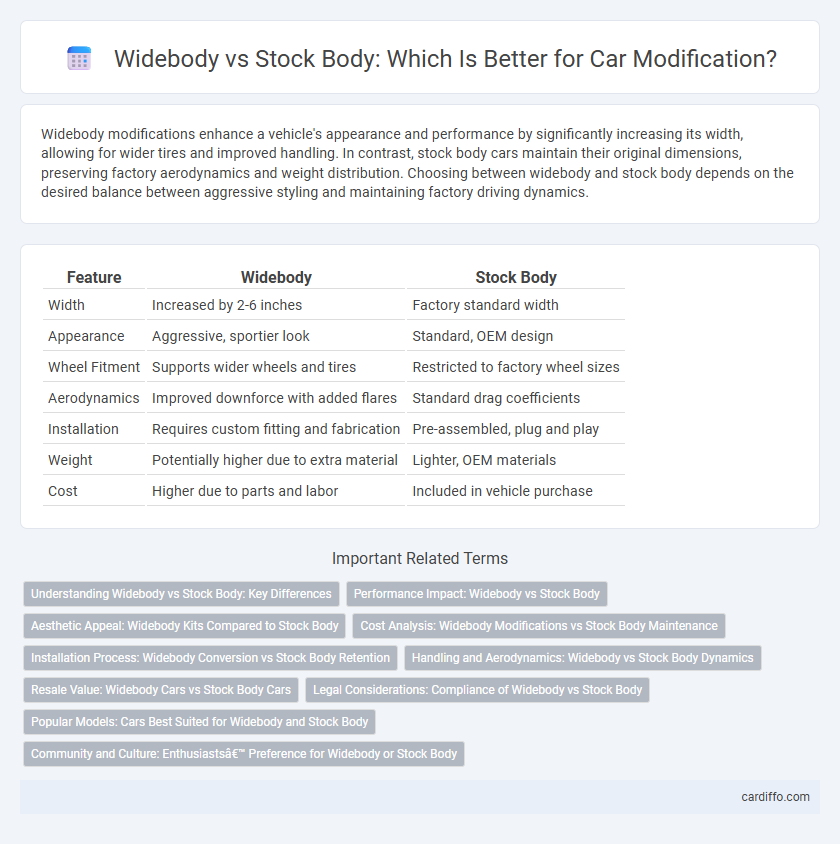Widebody modifications enhance a vehicle's appearance and performance by significantly increasing its width, allowing for wider tires and improved handling. In contrast, stock body cars maintain their original dimensions, preserving factory aerodynamics and weight distribution. Choosing between widebody and stock body depends on the desired balance between aggressive styling and maintaining factory driving dynamics.
Table of Comparison
| Feature | Widebody | Stock Body |
|---|---|---|
| Width | Increased by 2-6 inches | Factory standard width |
| Appearance | Aggressive, sportier look | Standard, OEM design |
| Wheel Fitment | Supports wider wheels and tires | Restricted to factory wheel sizes |
| Aerodynamics | Improved downforce with added flares | Standard drag coefficients |
| Installation | Requires custom fitting and fabrication | Pre-assembled, plug and play |
| Weight | Potentially higher due to extra material | Lighter, OEM materials |
| Cost | Higher due to parts and labor | Included in vehicle purchase |
Understanding Widebody vs Stock Body: Key Differences
Widebody modifications increase a vehicle's width by extending the fenders and adding wider wheels and tires, significantly improving grip and handling for performance driving. Stock bodies maintain the factory dimensions and aerodynamics, preserving the original structural integrity and design aesthetics. Understanding these key differences helps enthusiasts choose between enhanced maneuverability and maintaining stock appearance and function.
Performance Impact: Widebody vs Stock Body
Widebody kits significantly enhance performance by allowing wider tires, which improve traction, stability, and cornering grip compared to stock bodies. The increased width reduces body roll and aerodynamic drag, resulting in better handling and higher speed potential on track or street. Stock bodies maintain factory weight and aerodynamics but limit tire width and handling capabilities, restricting overall performance gains.
Aesthetic Appeal: Widebody Kits Compared to Stock Body
Widebody kits dramatically enhance a vehicle's aesthetic appeal by offering a more aggressive and dynamic stance compared to the stock body. These kits incorporate extended fenders and flared arches, creating a muscular and bold look that emphasizes performance and style. In contrast, stock bodies maintain a more conservative and factory-oriented design, prioritizing subtlety and mass-market appeal over striking visual impact.
Cost Analysis: Widebody Modifications vs Stock Body Maintenance
Widebody modifications typically cost between $3,000 and $15,000, driven by custom fabrication, wider fenders, and specialized paintwork, while stock body maintenance averages $500 to $2,000 annually depending on wear and repair needs. Widebody kits may increase insurance premiums by 10-20% due to higher repair costs and coverage complexity. Long-term expenses for widebody vehicles include potential frame reinforcement and specialized parts, which can outweigh the lower, more predictable maintenance costs of a stock body.
Installation Process: Widebody Conversion vs Stock Body Retention
Widebody conversion requires extensive modification to the vehicle's fenders, including cutting, welding, and reinforcement to accommodate wider wheels and tires, which significantly extends the installation time compared to stock body retention. Stock body retention involves preserving the original panel dimensions, allowing for simpler, faster installation with minimal structural changes and fewer alignment concerns. The widebody process demands precise measurements and specialized tools to ensure proper fitment and maintain vehicle integrity during modifications.
Handling and Aerodynamics: Widebody vs Stock Body Dynamics
Widebody modifications enhance handling by increasing tire width and track stability, resulting in improved cornering grip and reduced body roll compared to stock body configurations. Aerodynamically, widebody kits often include flared fenders and aggressive vents that optimize airflow, decrease drag, and increase downforce, whereas stock bodies prioritize factory-designed balance without significant airflow enhancements. These dynamic changes lead to better high-speed stability and more responsive steering in widebody setups versus the standard stock body.
Resale Value: Widebody Cars vs Stock Body Cars
Widebody cars generally have lower resale value compared to stock body cars due to their niche appeal and higher maintenance costs. Stock body cars retain broader market demand, making them easier to sell and often fetching better prices. Resale value differences are influenced by buyer preferences, with collectors favoring originality over extensive modifications.
Legal Considerations: Compliance of Widebody vs Stock Body
Widebody modifications often require compliance with stricter legal regulations compared to stock body vehicles, including adherence to local vehicle dimension limits and safety standards. Stock body vehicles generally meet factory-approved specifications, simplifying the approval process and reducing the risk of fines or failed inspections. Ensuring that any widebody kit is certified and installed according to legal guidelines is crucial to maintain roadworthiness and avoid legal penalties.
Popular Models: Cars Best Suited for Widebody and Stock Body
Widebody modifications are especially popular on cars like the Ford Mustang, Chevrolet Camaro, and Nissan GT-R, which benefit from enhanced aerodynamics and aggressive styling while accommodating wider tires for improved grip. Stock body configurations remain preferred for models such as the Honda Civic, Toyota Corolla, and Mazda MX-5 Miata, where maintaining factory dimensions preserves reliability, weight balance, and everyday drivability. Selecting between widebody and stock body depends heavily on the desired performance gains versus practicality and cost efficiency for each vehicle model.
Community and Culture: Enthusiasts’ Preference for Widebody or Stock Body
Enthusiasts in the automotive community passionately debate widebody versus stock body modifications, with preferences deeply rooted in culture and identity. Widebody kits symbolize aggressive customization and performance enhancement, attracting those who value bold aesthetics and exclusivity. Conversely, stock body purists often prioritize originality and heritage, fostering a culture that emphasizes authenticity and preservation within car communities.
widebody vs stock body Infographic

 cardiffo.com
cardiffo.com